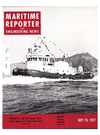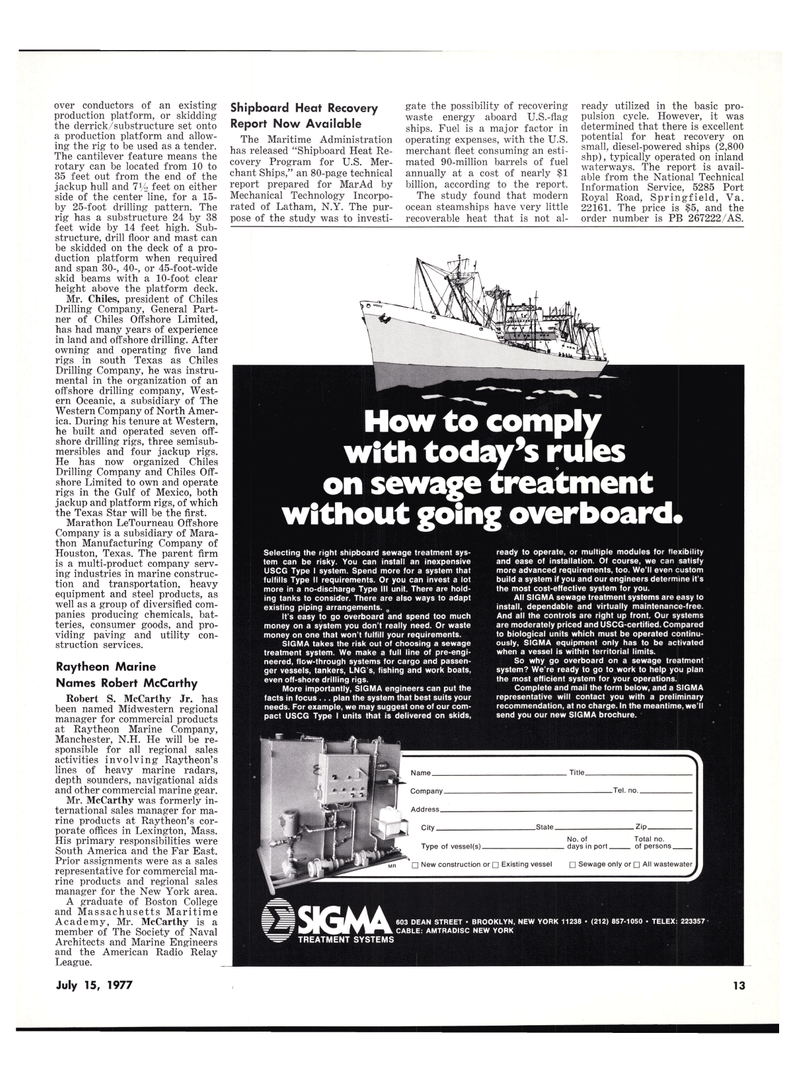
Page 11: of Maritime Reporter Magazine (July 15, 1977)
Read this page in Pdf, Flash or Html5 edition of July 15, 1977 Maritime Reporter Magazine
over conductors of an existing production platform, or skidding the derrick/substructure set onto a production platform and allow- ing the rig to be used as a tender.
The cantilever feature means the rotary can be located from 10 to 35 feet out from the end of the jackup hull and 7Vo feet on either side of the center line, for a 15- by 25-foot drilling pattern. The rig has a substructure 24 by 38 feet wide by 14 feet high. Sub- structure, drill floor and mast can be skidded on the deck of a pro- duction platform when required and span 30-, 40-, or 45-foot-wide skid beams with a 10-foot clear height above the platform deck.
Mr. Chiles, president of Chiles
Drilling Company, General Part- ner of Chiles Offshore Limited, has had many years of experience in land and offshore drilling. After owning and operating five land rigs in south Texas as Chiles
Drilling Company, he was instru- mental in the organization of an offshore drilling company, West- ern Oceanic, a subsidiary of The
Western Company of North Amer- ica. During his tenure at Western, he built and operated seven off- shore drilling rigs, three semisub- mersibles and four jackup rigs.
He has now organized Chiles
Drilling Company and Chiles Off- shore Limited to own and operate rigs in the Gulf of Mexico, both jackup and platform rigs, of which the Texas Star will be the first.
Marathon LeTourneau Offshore
Company is a subsidiary of Mara- thon Manufacturing Company of
Houston, Texas. The parent firm is a multi-product company serv- ing industries in marine construc- tion and transportation, heavy equipment and steel products, as well as a group of diversified com- panies producing chemicals, bat- teries, consumer goods, and pro- viding paving and utility con- struction services.
Raytheon Marine
Names Robert McCarthy
Robert S. McCarthy Jr. has been named Midwestern regional manager for commercial products at Raytheon Marine Company,
Manchester, N.H. He will be re- sponsible for all regional sales activities involving Raytheon's lines of heavy marine radars, depth sounders, navigational aids and other commercial marine gear.
Mr. McCarthy was formerly in- ternational sales manager for ma- rine products at Raytheon's cor- porate offices in Lexington, Mass.
His primary responsibilities were
South America and the Far East.
Prior assignments were as a sales representative for commercial ma- rine products and regional sales manager for the New York area.
A graduate of Boston College and Massachusetts Maritime
Academy, Mr. McCarthy is a member of The Society of Naval
Architects and Marine Engineers and the American Radio Relay
League.
Shipboard Heat Recovery
Report Now Available
The Maritime Administration has released "Shipboard Heat Re- covery Program for U.S. Mer- chant Ships," an 80-page technical report prepared for MarAd by
Mechanical Technology Incorpo- rated of Latham, N.Y. The pur- pose of the study was to investi- gate the possibility of recovering waste energy aboard U.S.-flag ships. Fuel is a major factor in operating expenses, with the U.S. merchant fleet consuming an esti- mated 90-million barrels of fuel annually at a cost of nearly $1 billion, according to the report.
The study found that modern ocean steamships have very little recoverable heat that is not al- ready utilized in the basic pro- pulsion cycle. However, it was determined that there is excellent potential for heat recovery on small, diesel-powered ships (2,800 shp), typically operated on inland waterways. The report is avail- able from the National Technical
Information Service, 5285 Port
Royal Road, Springfield, Va. 22161. The price is $5, and the order number is PB 267222/AS.
How to comply with today's rules on sewage treatment without going overboard.
Selecting the right shipboard sewage treatment sys- tem can be risky. You can install an inexpensive
USCG Type I system. Spend more for a system that fulfills Type II requirements. Or you can invest a lot more in a no-discharge Type III unit. There are hold- ing tanks to consider. There are also ways to adapt existing piping arrangements. „
It's easy to go overboard and spend too much money on a system you don't really need. Or waste money on one that won't fulfill your requirements.
SIGMA takes the risk out of choosing a sewage treatment system. We make a full line of pre-engi- neered, flow-through systems for cargo and passen- ger vessels, tankers, LNG's, fishing and work boats, even off-shore drilling rigs.
More importantly, SIGMA engineers can put the facts in focus ... plan the system that best suits your needs. For example, we may suggest one of our com- pact USCG Type I units that is delivered on skids, ready to operate, or multiple modules for flexibility and ease of installation. Of course, we can satisfy more advanced requirements, too. We'll even custom build a system if you and our engineers determine it's the most cost-effective system for you.
All SIGMA sewage treatment systems are easy to install, dependable and virtually maintenance-free.
And all the controls are right up front. Our systems are moderately priced and USCG-certified. Compared to biological units which must be operated continu- ously, SIGMA equipment only has to be activated when a vessel is within territorial limits.
So why go overboard on a sewage treatment system? We're ready to go to work to help you plan the most efficient system for your operations.
Complete and mail the form below, and a SIGMA representative will contact you with a preliminary recommendation, at no charge. In the meantime, we'll send you our new SIGMA brochure. 603 DEAN STREET • BROOKLYN, NEW YORK 11238 • (212) 857-1050 • TELEX: 223357
CABLE: AMTRADISC NEW YORK
July 15, 1977 13

 10
10

 12
12
